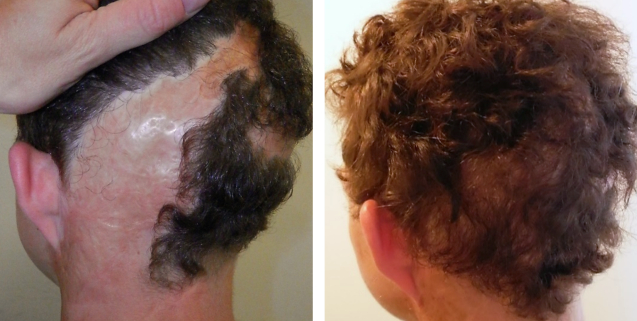
Hair transplants can be a helpful tool in a reconstructive context for individuals whose original follicles have been damaged beyond repair, but still have healthy donor sites. Many patients don’t realize that hair can actually be transplanted onto scarred skin. Granted, the grafts inserted to scarred areas do not take as reliably as those implanted in healthy tissue, but it is still the only way to grow hair from scarred areas. It is often best to undergo multiple transplants with fewer overall grafts. This is so that the grafts have the best chances of taking, to ensure an even appearance can be achieved in the long term, and that the supply of donor grafts is not exhausted when many will be necessary.
That there are many areas on the body from which hair can be extracted, and many areas into which hair can be grafted is especially important when considering a reconstructive hair transplant as it can open many doors that one might not have expected.
Generally, when performing transplants, the ideal donor site is the scalp. The hair in this region is fast growing, predictable and can generally be implanted into most areas of the body without looking out of place. The reverse is not always true, body, beard, and pubic hairs are not as predictable as those on the scalp. When it is not possible or preferable to use hairs from the scalp, donor sites aside from the scalp can become much more appealing and open the door to a more creative branch of hair transplantation.
If your scalp is a good donor site for hair transplant it is the preferred option. Areas of the scalp with scar tissue can receive grafts from healthy areas of the scalp. This procedure can be the best way to reconstruct a healthy hairline or fill in patches after an injury. Burns limited to areas of the scalp typically covered by hair can be completely hidden by a hair transplant in many cases. Hair transplantation to areas of injured hairline can have an incredibly positive impact on the aesthetic appearance of the injured area.
The scalp is the preferred donor site for hair transplant to the rest of the body. The scalp has the most hairs and many follicles can be extracted without any apparent thinning of the donor region allowing for large areas of the non-scalp to be covered. A hair transplant can go a very long way to blend a scarred region with the surrounding area.
Only the most experienced providers should be considered when looking for hair transplants where the scalp is not the donor area. These procedures are much more difficult, require a much deeper knowledge, and run a greater risk of looking unnatural when performed improperly. Results can be very impressive when performed by experienced providers or horribly noticeable when performed by a less experienced one.
Eyebrows are a fairly common area for transplant even when they have not been injured. The eyebrows can be implanted with nose hairs or body hairs when the scalp is not viable. Although these hairs might not be as predictable as the scalp, they can actually match the surrounding eyebrow hairs better, since these hairs are typically thinner than those of the scalp, and might not require regular trimming. Eyebrow transplants, because they require careful selection of grafts, must be placed with precision, and with incredible attention to the surrounding hair direction are best performed by artful providers such as Dr. Milchak. When performed by a less qualified provider, there is a greater risk that the hairs will not look natural after recovery as poor understanding of appropriate alignment and angle of hair will inevitably lead to a poor result.
Facial hair reconstruction can also benefit from non-scalp donor hair. Body hair, pubic hair, and other beard hairs can be good choices for facial hair reconstruction when the scalp is not a good option. It might not be possible to construct an entire beard from these sources, but they can do a great job of filling in thin or missing parts of a beard. Healthy beard hairs can make some of the best transplant grafts as they will obviously be the closest match for the missing bear hairs, but the use of beard hairs for transplant will necessitate thinning of the healthy follicles of the beard to acquire the necessary grafts, and will leave FUE dot scars that can be visible when the beard hair is shaved. Pubic hairs, because they are relatively thick like beard hairs, can also be a good choice for transplant although more care must be taken in the selection of donor follicles to best match the texture of the beard hair.
Body hair reconstruction is possible when non-injured body-hair donor sites are selected. The transplant of hairs from other parts of the body can simultaneously fill in hair of those areas which have been injured while reducing the appearance of the scars in the area. The hair transplant cannot heal any of the scaring, but can make it appear less noticeable when the scarred area is otherwise surrounded by hair. Body hair transplants are typically not recommended in those areas where hair did not grow prior to the injury. Although you may want obfuscate some scaring with hair, the final result might not look natural depending on the area in question and may in-fact draw more attention to the area.
These have been some of the more common non-scalp to non-scalp transplants, but this is by no means exhaustive an exhaustive list. Book a consultation with Dr. Milchak to discuss all the best options for your reconstructive hair transplant.